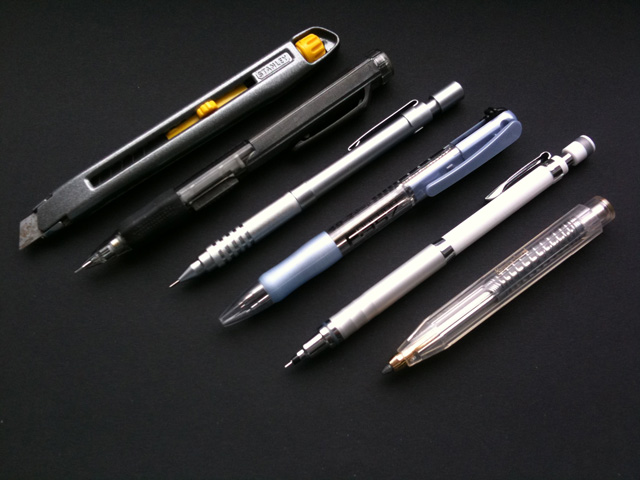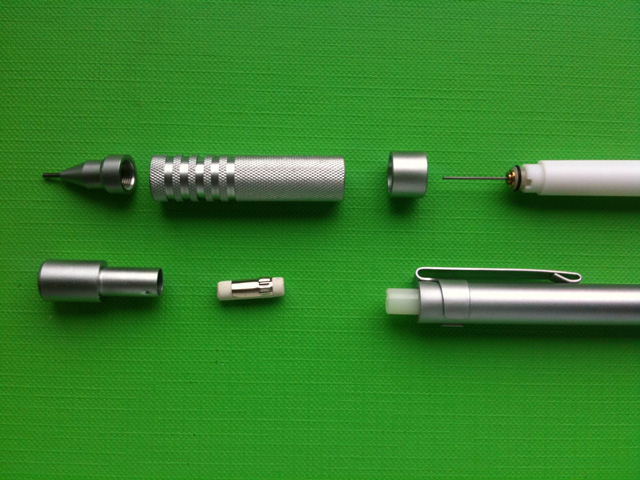Today, we are honored to have a guest post from Leon of Oude Tonge, Netherlands.

L. to R.: Stanley knife, Pentel Side FX 0.5 PD255, HEMA vulpotlood, Pentel Function .357, Uni Kuru Toga 0.5, Kaweco Sport
Since my schooldays, I haven’t done much work with a mechanical pencil. I have an education as a pre-press graphic designer and graduated in 1995. The Mac had taken over the pre-press world but our school was a little late to the party, so I still learned to work with paper, ink, huge cameras and chemically developed, rasterized film.
Outside of school and some internships I never used these (literally) old school techniques any more, but I still love the tools of the trade. I can’t resist buying them every once in a while, when I’ve found a new one that looks promising. Mechanical pencils (vulpotloden in Dutch) are among my favorites. Penciltalk.org was a eye opener. Apparently I am not the only one who likes mechanical pencils.
You’d think that, with the increased use of computers and the digital lifestyle becoming the standard, items like mechanical pencils would be used less and less or would even disappear completely. Fortunately, this is not the case, although they don’t get a lot of attention. They are there, but they are not advertised much. Still, I think some of these items have never been so high in quality while so affordable as now, in the 21st century.
I’m not a very active collector, but whenever I visit a warehouse or bookstore, I like to check the assortment of mechanical pencils. Of course, you’ll often find dozens of cheap lead holders usually mostly made of plastic, designed without any fantasy. Dull.
However, at the HEMA, a series of Dutch department stores, I found a nice exception. A full metal mechanical pencil. It comes with a single 0.5 mm lead to get you started and even though the eraser is too small for frequent use, the weight of it alone gives you confidence that it’s a serious piece of equipment.
HEMA is known for their ‘own’ products. Most are produced specially for them, to their specifications. Therefore, I wouldn’t be surprised if these mechanical pencils are not available anywhere else.
It is sturdy and handles well. The surface looks like aluminium but given the weight, I’d say it’s steel covered with a layer of aluminium. The metal clip is strong but flexible enough to be really useful. The body is sleek but the lower part is slightly wider, which makes it more comfortable to hold. The diamond shaped profile makes the grip much better and en passant makes it look like a piece of a fine mechanical instrumentation. In the center of the grip are some deeper laying rings that amplify this effect even more. All together, it’s a little gem among those plastic elements.

A closer look at the different parts of the HEMA mechanical pencil
Sincere thanks to Leon for contributing this excellent article. Photos and text by Leon. Since composing the article, Leon has noticed that the HEMA clip appears to be identical to that of the Rotring 600.

Leon, thank you for that detailed review of a great looking mechanical pencil! The simple and aesthetic design appeals to me, and I am happy to hear that its other qualities are matching.
Thank you. At some point, I thought it had the same point as the M.I.T. 3000 http://www.blift.de/main.php?g2_itemId=161 just like the clip seems borrowed from the Rotring 600 https://www.penciltalk.org/2009/07/knurly-the-rotring-600-mechanical-pencil/
Interestingly — speaking of Rotring 600 looks — I also found another model at HEMA that has a hexagonal barrel and a round, knurly grip. Like the Rotrng, it has no deeper laying rings, in contrast to the HEMA model above. It even has a brass lead tube, making it an almost 100% metal pencil. Then again, the clip is completely different from the Rotring 600 and HEMA mechanical pencil above.
Unfortunately, these mechanical pencils were a temporarily item and are no longer available at the HEMA.
Where can I buy an MIT 3000?
I have no idea, what brand is it?